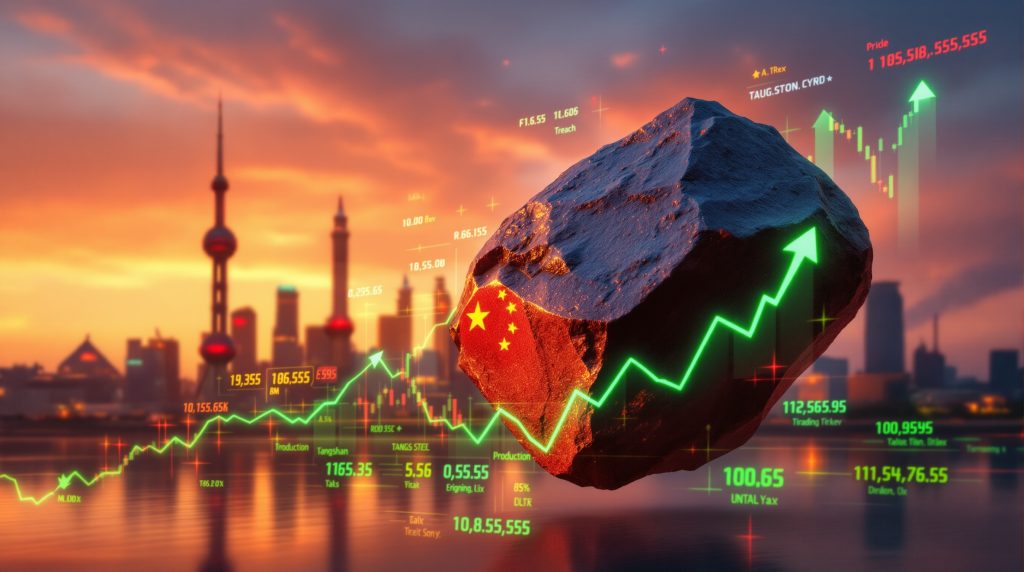What Caused the Recent Iron Ore Price Rebound?
Iron ore prices have staged a notable recovery after experiencing consecutive declines, marking a significant shift in market sentiment. The rebound comes as welcome news for investors and market participants who had been watching prices steadily fall over the previous trading sessions.
Short-Term Market Correction After Consecutive Declines
Iron ore futures on China's Dalian Commodity Exchange (DCE) closed 0.98% higher at 772.5 yuan ($107.63) per metric ton, breaking a six-session losing streak. Similarly, the Singapore Exchange benchmark September iron ore contract rose 0.55% to $101.3 per ton.
This price recovery represents a classic market correction following what many traders considered an oversold position. After six consecutive sessions of decline through mid-week, technical indicators suggested that prices had fallen below their reasonable value range, creating fertile conditions for a bounce.
A veteran commodity analyst who spoke with Reuters noted, "The market was due for a technical correction after sustained selling pressure. We typically see this pattern when prices fall too far, too fast without fundamental justification."
Production Restriction Impact Less Severe Than Expected
A key factor driving the iron ore price rebounds has been the realization that mandated production cuts in Tangshan—ahead of China's September 3 military parade—will be shorter than market participants initially feared.
"The length of the production restriction in Tangshan is shorter than expected, therefore the overall impact will be limited," confirmed an analyst familiar with the situation in comments to Reuters. This revelation dramatically shifted market sentiment from bearish to cautiously optimistic.
The military parade, commemorating the end of World War II, had prompted Chinese authorities to implement temporary production restrictions to improve air quality in Beijing. However, as details emerged about the limited duration of these measures, traders adjusted their positions accordingly.
Perhaps most importantly, "hot metal output, a gauge of iron ore demand, will likely hold steady this week, lending support to ore prices," according to another analyst who requested anonymity because they weren't authorized to speak publicly on the matter.
How Do China's Industrial Policies Affect Iron Ore Prices?
China's industrial policies play a pivotal role in global iron ore price movements, creating both short-term volatility and long-term structural shifts in the market. Understanding these policy mechanisms provides essential context for iron ore price forecast.
Regional Production Restrictions and Environmental Controls
Tangshan, China's largest steelmaking hub, regularly faces temporary production curbs as part of the country's broader environmental policy framework. These restrictions aim to improve air quality, particularly in Beijing, which sits approximately 150 kilometers northwest of the industrial center.
The upcoming military parade on September 3 commemorating the end of World War II has necessitated temporary production adjustments across the region's steel mills. This pattern of event-driven production curbs has become somewhat predictable for market participants, who have developed mechanisms to price in and absorb these recurring short-term disruptions.
What's notable about these policies is their increasingly targeted nature. Rather than implementing blanket production cuts across all facilities, Chinese authorities have been refining their approach to focus restrictions on the most polluting operations while allowing cleaner, more efficient producers to maintain higher utilization rates.
Long-Term Production Trends and Market Implications
Data from China's National Bureau of Statistics reveals that crude steel production in the country's top ten steelmaking regions decreased by 3.3% year-on-year from January to July. This decline represents a significant shift in the world's largest steel-producing nation and has profound implications for iron ore demand insights.
The production decline isn't uniform across China, with some provinces showing more significant reductions than others. This regional variation creates localized demand fluctuations for iron ore and other steelmaking inputs.
These structural changes in China's steel industry reflect the country's broader economic transition from infrastructure-led growth toward a more consumer-oriented economy. The government's emphasis on quality over quantity in steel production has led to consolidation within the industry, with larger, more efficient producers gaining market share at the expense of smaller operations.
Industry observers have noted that Beijing's dual-control policy on energy consumption continues to influence regional production decisions, creating a complex patchwork of supply dynamics that international iron ore suppliers must navigate.
What Are the Current Price Levels for Iron Ore?
Understanding current price levels provides essential context for assessing market conditions and potential future movements in the iron ore market.
Key Benchmark Prices and Recent Movements
The most-traded January iron ore contract on China's Dalian Commodity Exchange closed at 772.5 yuan ($107.63) per metric ton, representing a 0.98% increase from the previous session. This uptick breaks a six-day losing streak that had market participants concerned about further price decline analysis.
Simultaneously, the September iron ore contract on the Singapore Exchange rose 0.55% to $101.3 per ton. Both benchmarks had fallen consistently for six straight sessions through Wednesday before staging their recovery.
Current price levels remain within the medium-term trading range established over recent months, though they sit substantially below the historical peaks seen during 2021 when prices briefly exceeded $230 per ton amid post-pandemic supply constraints and robust Chinese demand.
The recent recovery suggests that market participants view the $100 per ton level as a significant psychological and technical support zone for iron ore price trends.
Price Comparison Across Global Markets
| Exchange | Contract | Price | Daily Change |
|---|---|---|---|
| Dalian Commodity Exchange | January Iron Ore | ¥772.5 ($107.63) | +0.98% |
| Singapore Exchange | September Iron Ore | $101.3 | +0.55% |
| Shanghai Futures Exchange | Rebar | Not specified | -0.03% |
| Shanghai Futures Exchange | Hot-rolled Coil | Not specified | -0.44% |
The current yuan-dollar exchange rate stands at 7.1776, an important factor that influences the relative cost of imported iron ore for Chinese buyers. Currency fluctuations can significantly impact purchasing power and, consequently, demand levels from the world's largest iron ore consumer.
The price divergence between different exchanges and contract months provides valuable information about market expectations regarding future supply-demand balances and highlights the dynamic nature of iron ore trading across global markets.
How Does Iron Ore Performance Compare to Other Steel Inputs?
The contrasting performance between iron ore and other steelmaking inputs reveals important insights about market dynamics and potential future price movements.
Contrasting Performance of Steelmaking Ingredients
While iron ore prices showed positive movement, other key steelmaking inputs experienced declines during the same trading session. Coking coal futures on the Dalian Commodity Exchange fell by 1.5%, while coke prices dropped 0.95%.
This divergent performance is unusual, as these inputs typically move in similar directions based on overall steel production expectations. When they move in opposite directions, it often signals changing fundamentals specific to each material's supply-demand balance.
The fact that iron ore prices increased while other inputs declined suggests that iron ore-specific factors—such as supply constraints or inventory adjustments—may be outweighing broader steel industry concerns.
Market analysts point to the importance of monitoring these divergences as potential early indicators of changing market dynamics that could impact future price movements across the steelmaking supply chain.
Steel Futures Performance Indicators
Despite iron ore's gains, steel futures on the Shanghai Futures Exchange universally declined during the same session:
- Rebar edged down 0.03%
- Hot-rolled coil lost 0.44%
- Wire rod eased 0.15%
- Stainless steel shed 0.27%
This broad weakness across finished steel products indicates that end-user demand remains insufficient to support higher steel prices, even as input costs for iron ore increase. This situation typically creates margin pressure for steelmakers caught between rising raw material costs and weak finished product prices.
The disconnect between raw material and finished product prices suggests that steel producers may need to consider production discipline to restore healthier margins if these trends persist.
What Factors Will Drive Future Iron Ore Price Movements?
Several key factors will influence iron ore prices in the coming months, from Chinese policy decisions to global supply dynamics and macroeconomic trends.
China's Steel Production Outlook
Hot metal output stability provides fundamental support for iron ore prices in the near term. As the analyst quoted by Reuters noted, steady hot metal production suggests continuous demand for iron ore despite temporary production restrictions.
However, the 3.3% year-to-date decline in production across China's major steelmaking regions indicates a structural shift that could impact long-term demand patterns. This production decline aligns with China's stated goals of controlling overall steel output to reduce carbon emissions and address industry overcapacity.
The upcoming economic planning meetings in China could result in policy shifts that significantly impact future China iron ore outlook. Particular attention should be paid to any announcements regarding infrastructure investment, property sector support, or environmental regulations affecting the steel industry.
Regional production variations will continue to create localized demand fluctuations, with some provinces potentially increasing output while others face stricter controls. This creates a complex mosaic of demand patterns that affects overall market balance.
Global Supply-Demand Balance
While the article focuses primarily on Chinese demand factors, global supply dynamics remain crucial for price formation. The production volumes from major exporters like Australia and Brazil will continue to influence market balance and price movements.
Port inventory levels in China serve as key indicators of market tightness. When inventories fall, prices typically rise in response to perceived supply constraints. Conversely, building inventories often pressure prices as they indicate weakening demand relative to available supply.
Production costs at major mining companies establish effective price floors during market downturns, as producers become reluctant to sell below their cost of production. This cost support provides a cushion against extreme price collapses during demand slowdowns.
Macroeconomic and Policy Considerations
China's property sector performance directly impacts steel consumption, as construction activities account for a significant portion of overall steel demand. Recent challenges in this sector have contributed to weakened steel demand and, consequently, affected iron ore prices.
Infrastructure investment decisions, particularly those related to China's economic stimulus measures, will influence medium-term demand outlook. Any acceleration in government-backed infrastructure projects would likely boost iron ore demand and support prices.
Environmental policies continue to shape production constraints, with Chinese authorities increasingly focused on reducing carbon emissions from the steel industry. This regulatory push encourages efficiency improvements and potentially limits overall production growth.
Currency movements, particularly the yuan-dollar exchange rate (currently at 7.1776), affect pricing dynamics by influencing the cost of imported iron ore for Chinese buyers. A stronger dollar makes iron ore more expensive in local currency terms, potentially dampening demand.
How Are Steel Prices Responding to Iron Ore Movements?
The relationship between iron ore and finished steel prices provides valuable insights into market dynamics and potential future developments.
Downstream Product Price Trends
All major steel benchmarks on the Shanghai Futures Exchange declined despite iron ore's gains, creating a notable divergence in the price relationship. Rebar, hot-rolled coil, wire rod, and stainless steel all showed modest losses during the same session when iron ore prices increased.
This price divergence indicates significant margin pressure for steelmakers, who face higher input costs without the ability to pass these increases on to end-users through higher finished product prices.
The uniform decline across different steel products suggests that end-user demand remains insufficient to support higher steel prices. This weakness appears to be broad-based rather than limited to specific sectors or applications.
Industry analysts have noted that steel price weakness amid rising input costs often precedes production cuts as manufacturers attempt to restore profitable operating margins. Such production discipline, if implemented, could eventually rebalance the market and support both steel and iron ore prices.
Steel Producer Margin Analysis
Rising iron ore costs alongside falling steel prices create a classic margin squeeze for steelmakers. While the partial offset provided by declining coking coal and coke prices offers some relief, the overall margin environment appears challenging.
Integrated producers with captive raw material sources maintain a competitive advantage in this environment. Companies that own iron ore or coking coal mines can better weather periods of input price volatility compared to producers who must purchase all raw materials at market prices.
The current price trends suggest that production discipline may become necessary to restore margins if the divergence persists. Historically, significant margin compression has eventually led to production curtailments that help rebalance the market and support price recovery.
Market participants should monitor capacity utilization rates at major steel mills for early signs of such production discipline, which could have significant implications for future iron ore demand and pricing.
FAQ: Understanding Iron Ore Market Dynamics
What is the significance of Tangshan to global iron ore markets?
Tangshan represents China's largest steelmaking hub, producing approximately 144 million tonnes of crude steel annually—equivalent to about 14% of China's total output. This massive production concentration means that policy decisions affecting Tangshan have outsized impacts on iron ore demand and pricing.
The city's proximity to Beijing (approximately 150 kilometers) makes it a frequent target for environmental restrictions, particularly during major events or periods of poor air quality in the capital. These recurring production curtailments create cyclical patterns in iron ore demand that experienced market participants have learned to anticipate.
Tangshan's steel industry serves as a microcosm of China's broader industrial policy direction, making production trends in this region a valuable leading indicator for national policy implementation affecting the steel sector.
How do military parades in China affect commodity markets?
Major events like military parades typically trigger temporary industrial production restrictions designed to ensure clear skies and reduced pollution in Beijing. These restrictions are usually announced in advance, allowing markets to price in the expected impact.
The production curtailments primarily affect heavy industries in provinces surrounding Beijing, including Hebei (where Tangshan is located), Tianjin, and parts of Shandong. Steel, cement, aluminum, and other high-emission industries face the most significant restrictions during these periods.
While markets typically anticipate these events, uncertainty about the actual duration and severity of restrictions often creates price volatility. In this case, the revelation that production restrictions would be shorter than initially feared contributed to the iron ore price rebound.
Why do iron ore and steel prices sometimes move in opposite directions?
This divergence occurs due to several factors, including different supply-demand dynamics, inventory levels, and cost structures at various points in the value chain.
When iron ore prices rise while steel prices fall, it typically indicates margin compression for steelmakers. This situation often results from:
- Specific supply constraints affecting iron ore (such as weather disruptions in Australia or Brazil)
- Inventory cycles where steel inventories are building while iron ore stocks are depleting
- End-user demand weakness that affects finished steel prices more directly than raw material costs
- Speculative trading activity that may impact futures contracts differently across commodities
If sustained, this price divergence eventually leads to production cuts as steelmakers seek to restore profitable margins, which in turn reduces iron ore demand and helps rebalance the market.
What exchange rate factors impact iron ore pricing?
The Chinese yuan to US dollar exchange rate (currently at 7.1776) significantly influences iron ore pricing because most global trade is denominated in dollars while Chinese domestic prices are in yuan.
When the yuan weakens against the dollar, imported iron ore becomes more expensive for Chinese buyers in local currency terms. This higher cost can dampen demand or force steelmakers to accept lower margins if they cannot pass the increased costs to their customers.
Conversely, a strengthening yuan makes imported iron ore less expensive for Chinese buyers, potentially stimulating demand and supporting global prices.
Beyond direct exchange rate effects, broader currency market trends often reflect macroeconomic conditions that independently affect commodities. For instance, dollar strength typically correlates with tighter global financial conditions, which can pressure commodity prices including iron ore.
Iron Ore Market Outlook
The iron ore market appears to be finding temporary equilibrium after recent volatility, with prices stabilizing above the $100 per ton psychological threshold. While short-term technical factors have supported the recent rebound, longer-term structural challenges remain for the industry.
China's evolving industrial policy, with its dual focus on environmental sustainability and economic stability, will continue to shape iron ore demand patterns. The 3.3% year-on-year decline in steel production across major Chinese steelmaking regions signals a structural shift that market participants must incorporate into their longer-term outlook.
The current divergence between rising iron ore prices and falling steel prices suggests market imbalances that will likely require adjustment through either production discipline, price corrections, or both. Monitoring this relationship provides valuable insights into potential future price movements.
For market participants, maintaining flexibility and closely tracking policy developments in China remains essential for navigating this dynamic commodity market. The iron ore price rebounds demonstrates the market's resilience, but sustainable price recovery will ultimately depend on fundamental improvements in end-user steel demand.
Want to Stay Ahead of Major ASX Mining Discoveries?
Discover how the proprietary Discovery IQ model instantly alerts investors to significant mineral discoveries on the ASX, turning complex data into actionable investment opportunities. Visit the Discovery Alert discoveries page to see how historic discoveries have generated substantial returns for early investors.




